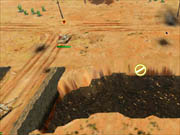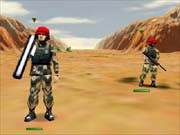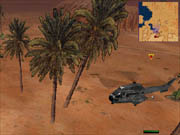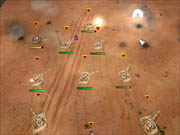Conflict Zone is a modern-day military real-time strategy game that has a unique resource system. It also touts its advanced artificial intelligence. The enemy is supposed to react to your actions in different ways every time, and you can have computer-controlled commanders help you in battles. It all sounds great in theory, but in practice, you'll find the AI only sporadically makes intelligent moves. Conflict Zone has a number of other problems, too. When the first wave of frustration passes, you'll realize that Conflict Zone is a subpar RTS game whose few good ideas just don't add up.

Conflict Zone is the stage for a war between the International Corps for Peace (ICP), a peacekeeping force like NATO, and GHOST, a secret self-serving group of nations. You can choose to play as either side in both the campaign and skirmish missions. Both sides are presented fairly well in the campaign missions, and the story is told through mildly amusing cutscenes. But while the ICP and GHOST are ideologically different, they are almost identical in terms of units and structures. The ICP scenarios are mostly peacekeeping missions in which you have to rescue civilians and then eliminate GHOST forces. These get so repetitive that, before each mission, you'll start to feel as if you're getting ready to go to work again on Monday morning after the weekend. The GHOST missions are a bit better because less emphasis is placed on rescuing civilians. It sounds boring that both sides have the same units, and it is. When playing a skirmish map, you might as well flip a coin because it basically doesn't matter which side you're on. Actually, that's not entirely true--the ICP and GHOST take slightly different approaches with regard to civilians and the media.
The resource model in Conflict Zone is interesting and unique. One of your resources is "popularity." It determines what level of units and technology you possess at any given moment. It's supposed to represent the trust that your leaders have in you, so a higher popularity means that they'll let you have bombers and submarines. The media directly influences your popularity by observing the actions you make in the game.
Popularity is the biggest differentiating factor between the ICP and GHOST. The ICP is able to increase popularity to high levels quickly simply by rescuing civilians and taking them to a refugee camp in their base. The downside to this is that the ICP also loses popularity quite easily. First, people generally don't like long wars, so the ICP's popularity slowly decreases over time. Next, if your forces suffer humiliating losses, the people back home aren't going to like you. Lastly, lots of civilian deaths at your hand will bring down your popularity big-time. A few civilian deaths are acceptable, though. But you're still going to have to avoid many battles near towns, because explosives have area-effect damage that can cause civilian casualties easily. And town buildings resupply civilians, so you don't want those destroyed.
Raising the GHOST's popularity takes more work than raising the ICP's popularity. Instead of a refugee camp, you have an enlistment camp. When you bring civilians there, they are converted to a random infantry unit on your side. This will raise your popularity to 50 percent, but no higher. As a mercenary general, you have to impress the GHOST leaders with favorable footage of successful battles. You can recruit cameramen to follow your troops. But if you're routed in combat, expect popularity to drop.

The main resources you get are command points. While the popularity resource is interesting, the command point system is frustrating. It seems to take forever to gain enough command points to build a decent-sized force. Granted, some waiting is involved in just about all RTS games, but Conflict Zone takes this to extremes. You can increase the rate of command point acquisition through rescuing civilians, but most of the time, they're behind enemy lines. And there are not many structures in the game, so building your base won't take much time at all. Therefore, you're going to just sit there twiddling your thumbs until you have collected enough command points to build troops. It's perfectly viable to get up and brew a cup of coffee or watch TV for a while and then come back to the game. The computer will rarely attack your base with a threatening force, so you don't have to worry about that. The command point system gets even worse in skirmish mode. All the combatants will get command points at a relatively equal rate, so there's no way to disrupt an opponent's economy. This means that there will be a lot of stalemates unless someone makes a really bad mistake.
The gameplay doesn't make up for the poor resource model. You're supposed to be able to make diversionary strikes at enemy forces, causing the enemy to reinforce that area and leave another area largely undefended. This works only once in a while, so you're back to the basic RTS ideal of winning by squatting in your base until you have enough troops to completely overwhelm the enemy positions. Infantry are largely useless because they die so quickly and move slow compared with vehicles. Since explosions will kill an infantryman instantly and infantry usually clump together, one tank shell or bazooka shot will send bodies flying. It leaves you to wonder why you can build a medic to heal injured troops, since troops never seem to survive more than a single hit.
Vehicles are much more useful because they take more of a beating before being destroyed; plus, you can repair them. Your main attack force is almost always going to be tanks and antiair defenses. Initially, the only infantry unit you'll ever want to build is the bazooka because it can fire at enemy aircraft, but even it soon outlives its usefulness since you'll gain antiair vehicles. So you'll learn to ignore infantry altogether. You're told that marines are good for sweeping towns because they won't accidentally kill civilians with splash damage, but in practice, you're better off just using vehicles--not caring if a few civilians die and not caring if you lose some popularity points. As long as you have enough to build tanks, you're fine.

The unit artificial intelligence is decent at best. Since units can't absorb much damage in Conflict Zone, there's no reason to concentrate fire on a single unit. The game does a good job with having units spread their fire on enemy groups. Your units will also fire while moving, which is a stress reliever in RTS games. On the other hand, unit pathfinding has some issues. Your units will eventually get to any point on the map, but they don't get there efficiently, much to your detriment. The biggest obstacles are bridges and ramps leading to elevation changes. Your groups can't seem to tackle these without getting slaughtered. The scale shows that five infantry and a couple of tanks can easily cross abreast of each other, yet they all insist on going single-file through these locations. Anyone can see the obvious choke points that result. There also aren't any formations to protect weaker units such as artillery and antiair troops. A group won't move at the rate of the slowest member. If your advancing tank column runs ahead and gets taken out, then you're going to have to retreat everything else that lagged behind. This is yet another reason why infantry are more trouble than they're worth. Some skirmish maps also place bases in areas where your army simply refuses to go. It appears to be impossible to win these scenarios with armies, so the last person to quit is the victor.
Conflict Zone includes up to four AI-controlled battle commanders per side that can assist you in combat. You can have them handle a variety of tasks such as improving your base, attacking or defending a position, and concentrating on rescuing civilians. The latter is probably the only option that's really useful. Rescuing civilians is a tedious task, and if someone else is willing to do it for you, more power to them. You can share resources with commanders and give them units to control on their own. But sharing command points means that you'll have to wait even longer to build a force. Now, you can do errands while they build up your base and a bunch of units. But by then, what's the point of playing the game in the first place? The commanders do have their fair share of problems. Sometimes they will refuse to build anything and just sit there collecting money. Perhaps it's a testament to the advanced AI in the game--as in the movie War Games, perhaps the computer is simply realizing that it's a part of a fruitless game.
The games' 3D graphics are utilitarian: They do the job but aren't anything to write home about. Unit models are bland, but they hold up well when you're zoomed in close. Yet another problem with infantry is that they are quite small when you're zoomed out, which is the view that a typical strategy gamer has to use to get a full scope of the battlefield. It's so bad that you can't even tell the difference between a cow and an enemy marine without floating your mouse over it first.

On the other hand, Conflict Zone's interface is nonobtrusive and works well enough. When you select a group of units, you're told the types and number you have selected on the left-hand side of the screen. You have a minimap in the top right-hand corner that expands when you float your mouse pointer over it. The only other main interface feature is the build menu in the bottom left. It's real easy to cycle through and build anything you want. You don't even have to select a factory-type building to buy units. The camera is done fairly well, but you can only use the mouse at the edge of the screen to adjust the perspective. There are other strategy games that let you hold down the buttons and move the mouse to rotate and elevate the camera--it's too bad that this wasn't implemented.
Conflict Zone isn't a completely terrible game, but there's nothing about it that will scream for you to play it. Most mainstream strategy gamers will most likely find it painful to play. Besides, this is a great time for strategy games, so Conflict Zone's fierce competition makes it even less recommendable. And if Conflict Zone's AI even gives up, then perhaps it's trying to tell you something. Hard-core strategy gamers might find something to like in the game's unusual resource system. But not even that and the game's cheap price of $19.99 justifies a purchase. You can easily pick up older games that look and play better than Conflict Zone.